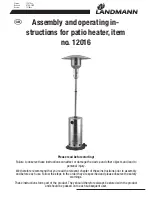
REGULAR CARE
12
TEMPERATURE PRESSURE RELIEF VALVE
This valve is near the top of the water heater and is essential for
its safe operation. It is possible for the valve to release a little
water through the drain line during each heating period. This
occurs as the water is heated and expands by approximately
1/50 of its volume.
Continuous leakage of water from the valve and its drain line
may indicate a problem with the water heater (refer to
“Temperature Pressure Relief Valve Running”
on page 16).
Warning:
Never block the outlet of this valve or its drain line
for any reason.
Operate the easing lever on the temperature pressure relief
valve once every six months.
It is very important you raise
and lower the lever gently.
DANGER:
Failure to do this may result in the water heater
cylinder failing, or under certain circumstances, exploding.
Warning:
Exercise care to avoid any splashing of water, as
water discharged from the drain line will be hot. Stand clear of
the drain line‟s point of discharge when operating the valve‟s
lever.
If water does not flow freely from the drain line when the lever is lifted, then the water heater must be
checked. Phone Rheem Service or their nearest Accredited Service Agent to arrange for an inspection.
The temperature pressure relief valve should be replaced at intervals not exceeding 5 years, or more
frequently in areas where there is a high incidence of water deposits (refer to
“Water Supplies”
on page 13).
EXPANSION CONTROL VALVE
In many areas, including South Australia, Western Australia and scaling water areas, an expansion control
valve is fitted to the cold water line to the water heater. The expansion control valve may discharge a small
quantity of water from its drain line during the heating period instead of the temperature pressure relief valve
on the water heater.
Operate the easing lever on the expansion control valve once every six months.
It is very important you
raise and lower the lever gently.
The expansion control valve should be checked for performance or
replaced at intervals not exceeding 5 years, or more frequently in areas where there is a high incidence of
water deposits.
COLLECTOR GLASS
Ensure the glass on your solar collectors is free of dust, salt spray or any other matter, which may reduce the
effectiveness of the solar collectors. If the collector glass becomes dirty, hose down or if the solar collectors
are accessible, wash the collector glass with water and a soft brush when the solar collectors are cool.
Have any trees trimmed which may shade the solar collectors.
Rheem solar collectors have passed the AS/NZS 2712 requirements for resistance to hailstone damage, so
it is not normally necessary to fit a guard to a collector. Stone Guards are available to provide a level of
protection to the collectors against vandalism or accidental damage. Refer to your local Solar Distributor for
details.
lift until water
flows from the
drain line –
lower gently
drain
line
water
heater
Содержание Premier Hiline
Страница 26: ...INSTALLATION 26 TYPICAL INSTALLATION SOLAR PREMIER HILINE 180 TYPICAL INSTALLATION RHEEM PREMIER HILINE 52H180...
Страница 27: ...INSTALLATION 27 TYPICAL INSTALLATION SOLAR PREMIER HILINE 300 TYPICAL INSTALLATION RHEEM PREMIER HILINE 52H300...
Страница 50: ...50 This page is intentionally blank...













































